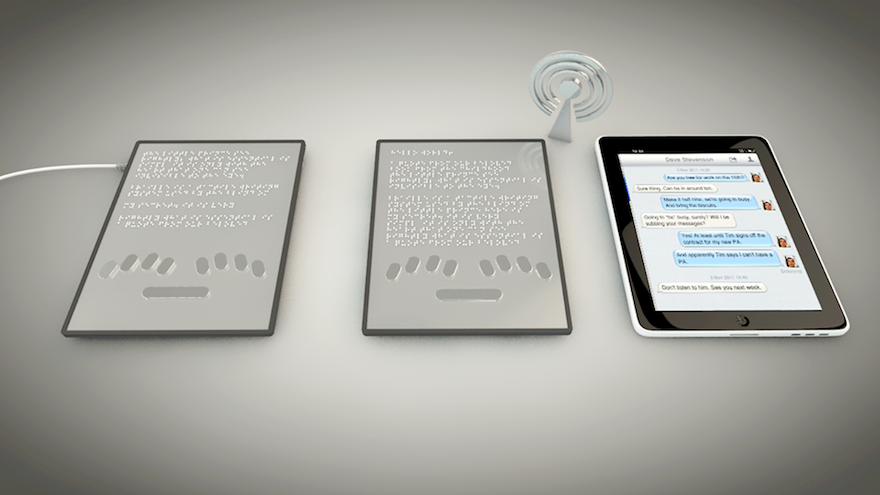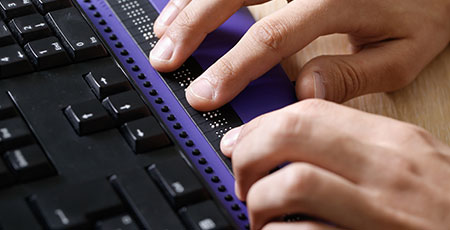OCR Devices for the Blind: Changing Print to Speech in Real-Time
OCR Devices for the Blind: Changing Print to Speech in Real-Time
Blog Article
Discover Cutting-edge Tools Designed for the Aesthetically Impaired
The development of cutting-edge tools for the visually impaired represents a considerable advancement in ease of access and self-reliance. Technologies such as smart glasses with AI capabilities and mobile applications created to give acoustic descriptions are reshaping daily experiences for customers.
Smart Glasses for Navigation

Smart glasses designed for navigation are changing the method aesthetically impaired people communicate with their environment. These advanced gadgets use a combination of electronic camera innovation, artificial knowledge, and auditory feedback to provide real-time details regarding environments. By using barrier detection systems, wise glasses can signal customers to prospective risks, enabling more secure movement in both strange and acquainted settings.
The integration of GPS modern technology better enhances navigating capabilities, enabling users to get auditory instructions as they relocate. This hands-free technique not only fosters freedom yet likewise empowers visually damaged individuals to browse metropolitan landscapes with boosted confidence. Additionally, many smart glasses are outfitted with features that determine sites and street indications, providing contextual info that enhances the customer experience.
In addition, the development of these devices is consistently progressing, with business functioning to enhance the precision of item acknowledgment and broaden the range of navigational attributes. As clever glasses become a lot more inexpensive and easily accessible, they hold the prospective to substantially change day-to-day live for aesthetically damaged users. Eventually, these innovative devices represent a vital step towards inclusivity, offering improved wheelchair and a greater sense of freedom for individuals navigating the world around them.

Mobile Apps for Daily Living
Exactly how can mobile applications enhance the day-to-day lives of visually damaged individuals? Mobile applications are reinventing the method visually impaired users navigate their environments, manage daily jobs, and access information. These applications offer vital support via various functionalities, fostering self-reliance and boosting top quality of life.
Numerous ingenious mobile apps are designed specifically for daily living. Apps like Be My Eyes connect aesthetically impaired individuals with sighted volunteers using video calls, permitting them to receive real-time assistance with tasks such as checking out tags or navigating unfamiliar areas. Seeing AI, created by Microsoft, makes use of artificial knowledge to explain environments, read text, and determine items, properly transforming a smartphone into a powerful device for daily support.
Furthermore, navigation applications tailored for the visually damaged, such as Aira and BlindSquare, provide audio-based instructions and environmental details, enabling individuals to traverse their environments safely and confidently. Past navigation and immediate aid, mobile applications also sustain organization and task monitoring, with attributes that assist customers set pointers, create order of business, and track visits. In recap, mobile applications work as essential sources, encouraging visually damaged individuals to lead even more independent and meeting lives.
Wearable Technologies for Help
Empowerment through modern technology is progressively evident in the realm of wearable gadgets made to help aesthetically impaired individuals. These cutting-edge devices incorporate seamlessly right into life, improving navigating and providing vital comments to users. Smart glasses geared up with cams can identify faces and review message aloud, permitting users to engage even more confidently in social and professional setups.
Another remarkable advancement is making use of haptic feedback systems in wearable gadgets. These systems use click this site resonances or various other tactile signals to share details regarding the customer's environment, such as challenges or adjustments in surface, improving mobility and safety. Wearable innovations additionally consist of wristbands that attach to smartphones, alerting customers to notifications with subtle vibrations, thus enhancing connectivity without dependence on aesthetic cues.
As these modern technologies remain to progress, they are not only boosting self-reliance for aesthetically damaged people but also promoting a better sense of addition in culture. By connecting the void between obstacles dealt with in daily living and the possibility for freedom, wearable technologies act as pivotal devices in the mission for equal rights and empowerment for those with visual problems.
Audio Description Devices
Audio description devices play a crucial duty in enhancing availability for visually impaired individuals, offering them with the capacity to engage with visual media. Speech-to-text devices for low vision. These tools supply narrated summaries of essential visual aspects in films, tv programs, and live efficiencies, making certain that individuals can fully comprehend the context and emotions communicated through visuals
Audio description can be integrated into various systems, consisting of streaming services, movie theater screenings, and live movie theater. Many popular streaming services now include audio summary as an ease of access function, allowing visitors to pick it quickly. Along with traditional media, specialized applications also exist, giving audio descriptions for art exhibitions, galleries, and other social events.
The effectiveness of audio summary pivots on the ability of the storytellers, that should communicate visual details succinctly without interfering with the initial sound. Developments in this field are likewise paving the means for more individualized experiences, where customers can readjust the degree of detail and pacing according to their preferences.
Braille Innovations and Gadgets
Braille tools and technologies have actually substantially changed visit homepage the method aesthetically impaired individuals communicate with text and information. Modern advancements have actually resulted in the advancement of versatile tools that improve proficiency and freedom amongst users. Significantly, Braille show technologies have evolved, permitting vibrant analysis experiences. These tools transform digital message into Braille, enabling individuals to access a substantial selection of information on tablet computers, smart devices, and computers.
Furthermore, portable Braille notetakers combine conventional Braille input with contemporary performances, assisting in note-taking, organizing, and record editing and enhancing on the move. Assistive technology for the blind. These compact tools usually feature text-to-speech abilities, connecting the space between Braille and acoustic info
On top of that, cutting-edge Braille printers have emerged, allowing individuals to create Braille tags, records, and academic materials efficiently. This ease of access fosters better engagement in professional and instructional settings, eventually promoting inclusivity.
In addition, research into smart Braille modern technologies remains to expand. Devices that incorporate expert system are being checked out to supply real-time navigating aid and contextual info, improving the customer experience in varied settings. Generally, these advancements mirror a commitment to equipping visually impaired people via modern technology, ensuring they can quickly access and involve with the globe around them.

Conclusion
The improvement of innovative tools for the aesthetically impaired significantly improves freedom and quality of life. These modern technologies not only foster higher addition yet likewise promote autonomy in daily activities, ultimately adding to a more available and equitable society review for visually damaged people.
As smart glasses become extra affordable and accessible, they hold the potential to significantly transform daily life for aesthetically impaired individuals. Mobile applications are reinventing the way aesthetically damaged individuals browse their environments, take care of everyday tasks, and accessibility info. Apps like Be My Eyes connect aesthetically impaired individuals with sighted volunteers through video phone calls, allowing them to get real-time support with jobs such as reviewing labels or browsing strange rooms.Furthermore, navigating apps customized for the visually damaged, such as Aira and BlindSquare, provide audio-based instructions and ecological info, making it possible for users to traverse their environments safely and with confidence.The development of cutting-edge devices for the visually impaired dramatically enhances freedom and high quality of life.
Report this page